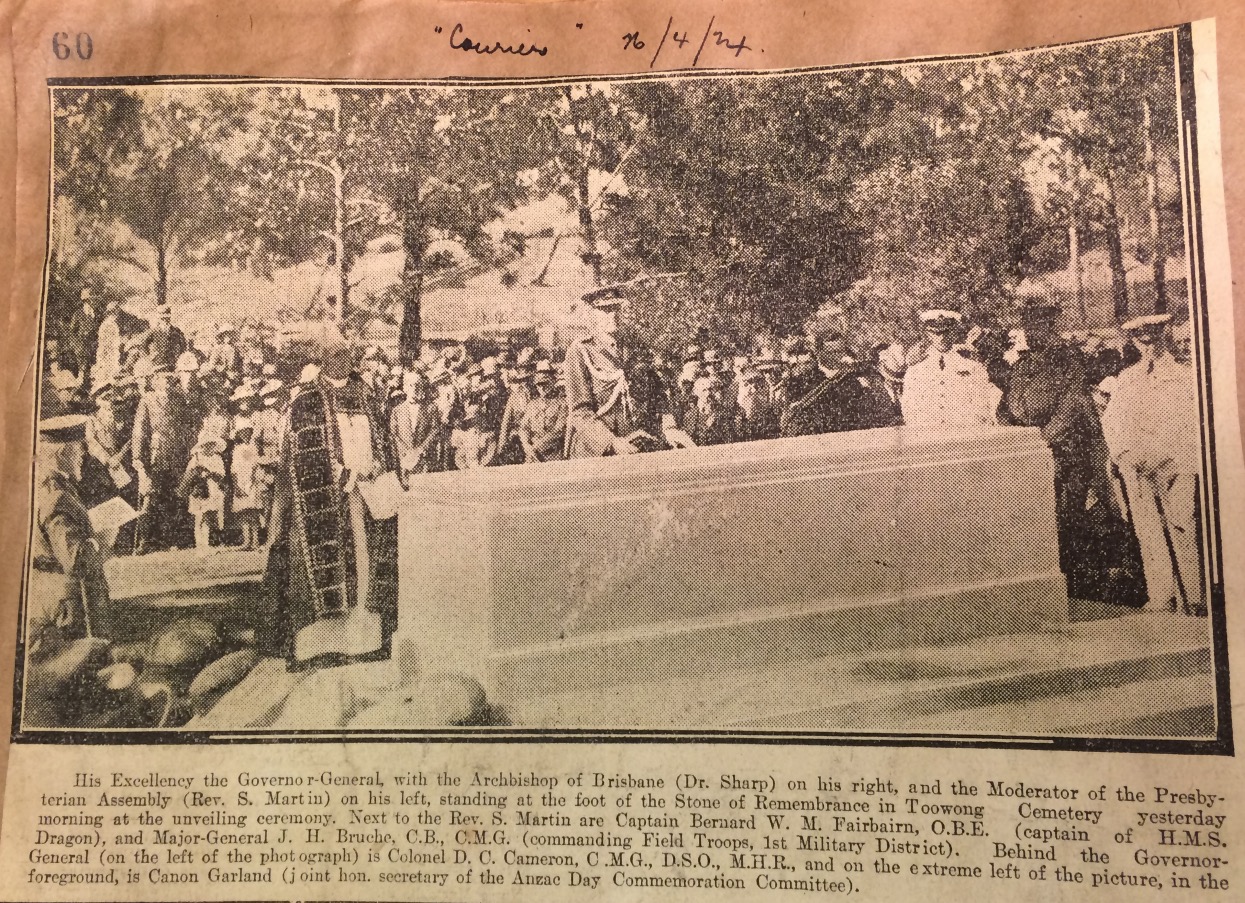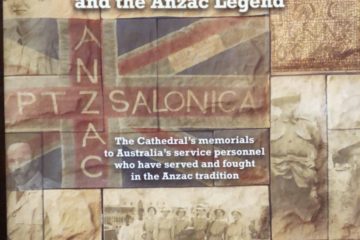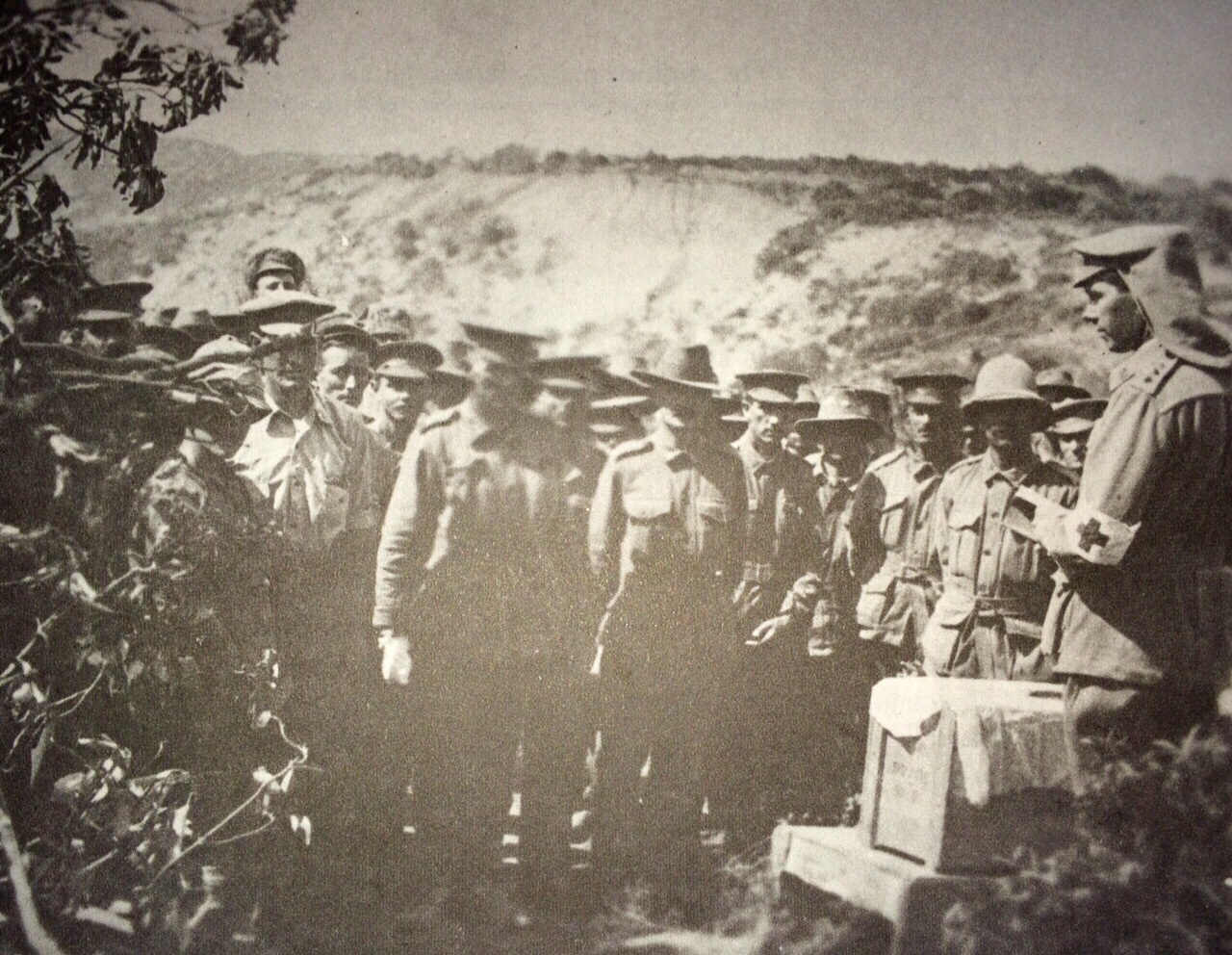Remembrance editorial

ABOVE: Included in the State Library of Queensland Collection’s ANZAC Day Commemoration Committee (Queensland) Records (OMHA/2, Box 3550), is this original clipping from page 8 of “The Brisbane Courier” (Brisbane) of 26 April 1924. It depicts the Australian Governor-General, Sir Henry William Forster (Lord Forster), unveiling of the Stone of Remembrance at Toowong Cemetery the day before. Lord Forster, with the Archbishop of Brisbane (Dr. Gerald Sharp) on his right, and the Moderator of the Presbyterian Assembly (the Rev. Samuel Martin) on his left, stands at the foot of The Stone of Remembrance. Next to the Rev. Martin are Captain Bernard William Murray Fairbairn, O.B.E. (captain of H.M.S. Dragon), and Major-General Sir Julius Henry Bruche, C.B., C.M.G. (commanding Field Troops, 1st Military District). Behind the Governor-General (on the left of the photograph) is Colonel [later Sir] Donald Charles Cameron, C.M.G., D.S.O., M.H.R., and on the extreme left of the picture, in the foreground, is Canon Garland (joint honorary secretary of the Queensland Anzac Day Commemoration Committee), in his First AIF Chaplain Lieutenant-Colonel’s uniform.
REMEMBRANCE.
THE most massive stone ever hewn from a Queensland quarry is being dedicated today [ 25 April 1924 ] to the memory of those who fell or died of wounds or sickness as our soldiers in the Great War.
There is an ancestral touch about this memorial, a reminiscence of those hoary monoliths and cromlechs that are the sole mark on English soil of heroes whose dust, whose names, and whose deeds had otherwise passed into absolute oblivion.
A nation touched to the quick expresses itself in modes that go back to the roots of the race.
And nothing stirs, or has ever stirred, the heart of a great people like the spectacle of those who have died for their country.
The majesty of that sacrifice no years can dim.
Sorrow, and lamentation for the loss of the best and bravest inevitably become transmuted from passionate grief and longing to proud recollection of the loved and lost, whose earthly history had been arrested at the noblest moment of their lives, and fixed forever in the serenity of unwaning greatness.
The time for tears is past, but never the time for remembrance.
The Anzac Commemoration Committee has never failed in its effort to mark this day with dignity and propriety as is fitting of the place where the thought of keeping it as a day apart was born, but it has never more appropriately expressed the deepest and tenderest emotions evoked by Anzac Day than it has done on this ninth anniversary in the solemn dedication of a “Stone of Remembrance.”
Its massive stability is emblematic of the enduringness of our love and reverence for those who were our buttress in the day of calamity, and who themselves, rocklike, withstood the submerging waves of chaos that raged about them.
It is the replica of those great stones which stand near the entrances of all the great war cemeteries, and so links our God’s acre of three hundred and fifty soldier graves with those in the fields of France, the gullies of Gallipoli, the jungle of New Guinea, the “holy fields” of Palestine, and the mother earth of Britain.
Like these, also, this cyclopean stone bears no names upon it, neither of those who erected it nor of those for whom it is meant to be an everlasting remembrance.
It thus becomes to all alike, fathers and mothers, brothers and sisters, a memorial of their boy.
And like The Cenotaph in London, this huge Helidon stone will be the place of meeting where the representatives of the King, the Governor-General [ Sir Henry William Forster ] and the Lieutenant-Governor [ Hon. William Lennon ] today, will salute the deathless army, and where on the great public anniversaries commemorating the beginning and end of our Australian warfaring, as well as on those sacred private anniversary days in the calendar of families, wreaths of flowers for remembrance may be laid.
The Stone of Remembrance has a further office to perform to the people of this community.
It stands as witness to a task well done. It is also a rallying point for service yet to do for our country.
“Pessimism in the civilian is the counterpart of cowardice in the soldier.”
Those heroic men who scaled the heights of Gallipoli and who fought unflinchingly on Flanders fields beckon to us imperiously:
To you from dying hands we throw
The torch. Be yours to bear it high —
If ye break faith with us who die
We shall not sleep, tho’ poppies grow
In Flanders fields.
They did not do well for themselves in any material sense, but they did well for their country, and The Stone of Remembrance is a perpetual challenge to all our citizens to give disinterested service to this great heritage which is ours, not simply by the good fortune of possession, but doubly ours because of the indomitable metal of Australia’s sons who bled in her defence.
The Anzac touch is needed to solve our great civil and developmental problems, a well-considered daring, which in a great State like Queensland should preserve us “from craven fears of being great”.
But most obvious of all our duties, and that one to which this Commemoration Day specially summons us, is the paramount duty of national defence.
The exacting price of maintaining our splendid heritage is perpetual vigilance and self-discipline.
The naval men of the Squadron [ H.M.S. Dragon of the Royal Navy’s Special Service Squadron ] who are with us today remind us by their presence that Britain has paid ungrudgingly the price of Imperial safety on the sea.
In the maintaining of this security Australia has her share, for on it our national existence veritably depends.
Such a task permits of no improvisation when the hour of peril arrives.
It is one we cannot shun, whatever glib-tongued peacemongers may say.
The Stone of Remembrance points the way to The Cross of Sacrifice, and Anzac Day reminds us, and those who hold the reins of our Governments, that we must keep faith with our heroic dead, a trust we only fulfil by resolute preparedness to defend our own by land and sea.
— the page 4 Editorial from “The Brisbane Courier” of Friday, 25 April 1924.


